Saving cucumbers from diseases and pests: important recommendations
Cucumbers are a popular garden crop, which in the climatic conditions of our country is one of the first to produce a harvest. She is not afraid of slight temperature changes and heavy rains, so even novice gardeners can cope with agricultural technology.
Obtaining a rich harvest is often hampered by plant diseases. Due to high humidity and other reasons, dozens of diseases and pests attack summer residents’ plantings every year. The article will tell you about the main diseases and the most dangerous pests of cucumbers, as well as ways to combat them.
Main causes of plant diseases
Cucumbers get sick due to gardener mistakes or negative environmental factors. The main causes of damage to melons and melons:
- Violation of watering rules. There are diseases that develop at high humidity, and there are pathogens that are activated in dry soil.
- Cold snap. Cool weather combined with high or low humidity is especially dangerous. Disease outbreaks are more likely to occur after heavy rains.
- Contaminated soil. Pathogens overwinter not only in the soil, but also on garden tools, plant debris and even in planting material.
- Lack or excess of nutrients or microelements in the soil. This leads to weakened immunity of cucumbers.
- Pests and weeds. They act as carriers of many viral and fungal diseases.
- Thickened plantings and earthen crust.This prevents air exchange.
- Increased acidity. Some microorganisms develop best in such conditions.
- Violation of the rules of stepsoning. Infections easily penetrate into the “wounds” created when pruning bushes.
Diseases of fungal origin
Fungal diseases damage cucumbers more often than others. Pathogen spores enter plants from the soil, from neighboring plants, and from pests. Some of them are transmitted by airborne droplets.
There are more than ten diseases of cucumbers of fungal origin. Each of them develops under certain conditions and is treated in its own way.
Powdery mildew
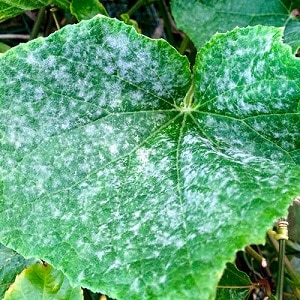 Powdery mildew – the most common disease that affects almost all fruit plants. The photo will help to identify this disease in time. At the beginning of development, a coating of white spots appears on the leaves of the plant. It looks as if the bushes have been sprayed with lime. Later, the entire plant is covered with a white coating. Shoots and ovaries begin to fall off from it. Even if some ovaries are preserved, they will produce small and ugly fruits.
Powdery mildew – the most common disease that affects almost all fruit plants. The photo will help to identify this disease in time. At the beginning of development, a coating of white spots appears on the leaves of the plant. It looks as if the bushes have been sprayed with lime. Later, the entire plant is covered with a white coating. Shoots and ovaries begin to fall off from it. Even if some ovaries are preserved, they will produce small and ugly fruits.
The following factors provoke the development of infection:: cooling in conditions of high humidity, an abundance of weeds and thickened plantings, drafts and frosts.
If signs of disease occur, it is possible to save the plants. The following methods are used for this:
- When the first symptoms of powdery mildew appear, all affected parts are torn off and burned. Plants are sprayed with a light pink solution of potassium permanganate.
- If the plantings continue to hurt, or the damage was not noticed at an early stage, then the plants are treated with sulfur.To do this, pour 40 g of ground sulfur for every 10 m² or pour in 10 liters of water with the addition of 30 g of 3% colloidal sulfur.
- Folk remedies include spraying bushes with mullein solution. 1 kg of rotted manure is added to 10 liters of water.
- Feeding with potassium will help strengthen the immunity of cucumbers to infection.
- If the disease continues to progress, the plantings are treated with chemicals “Oxyx” or “Topaz”.
Downy mildew, or downy mildew
Downy mildew also called downy mildew. With this disease, the leaf blades become covered with light green spots., which appear first at the top of the sheets. The disease progresses rapidly, attacking the entire plant. Over time, purple formations appear on the inside of the sheets.
Disease develops due to high humidity. Fungus reproduction is activated by condensation and dew.
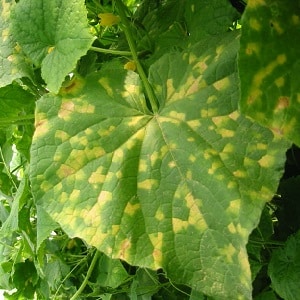 Treatment of peronosporosis:
Treatment of peronosporosis:
- treating plantings with milk - take 1 liter of milk and 10 drops of iodine for 9 liters of water, spray the plants with the solution;
- urea - take 10 g of powder per 10 liters of water;
- Bordeaux mixture - bushes are sprayed with its solution;
- chemicals (“Topaz”).
It is recommended to cut off all affected parts of the plant. Downy mildew is difficult to treat with folk remedies. It is not recommended to plant melons in beds where there has been an outbreak of this disease for three years.
Root rot
Root rot affects the root of the plant. First, part of it begins to rot, and later the entire system, right down to the root collar, becomes ill. In the final stages, the stem rots and collapses, which leads to the death of cucumbers.
Disease develops when watered with cold water. An epidemic may occur during cold weather, especially if it is accompanied by precipitation.
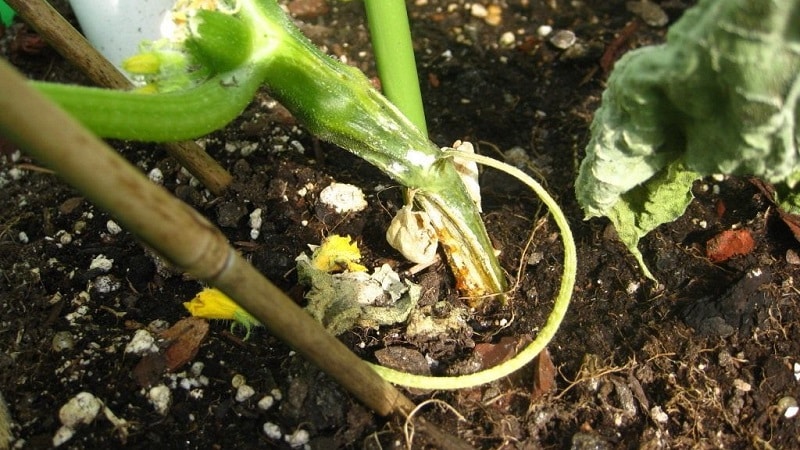
White rot, or sclerotinia
White rot, aka sclerotinia, develops with temperature changes and thickened plantings. It more often affects plants in a greenhouse than in open ground.
When affected by sclerotinia Slimy white spots appear on the above-ground parts of plants. Gradually the plants begin to rot and die.
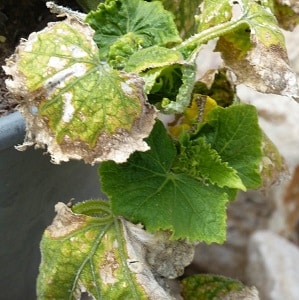 How to deal with cucumber diseases:
How to deal with cucumber diseases:
- The affected parts are cut off. The cut areas are treated with ash. If plaque appears on the stem, it is carefully removed and the wound is treated with ash.
- The soil between rows or greenhouses is disinfected with preparations containing copper. Additionally, the plantings are fed with a mixture of 10 liters of water, 10 g of urea and 2 g of copper sulfate.
It is useless to treat sick plants. They are removed from the garden and burned. To prevent infection of healthy plants on the site, the soil is sprinkled with bleach at the rate of 20 g per 1 m².
Gray rot
About gray rot evidenced by gray weeping spots on the fruits and greenery of the cucumber. Over time, the fruits completely rot, and the bush loses turgor and dries out.
At the initial stages of the disease the affected parts of the plants are removed, and the bushes are treated with Roval. If after this the damage to the crop continues, the diseased bushes are removed and burned, the remaining plantings are treated with antifungal agents.
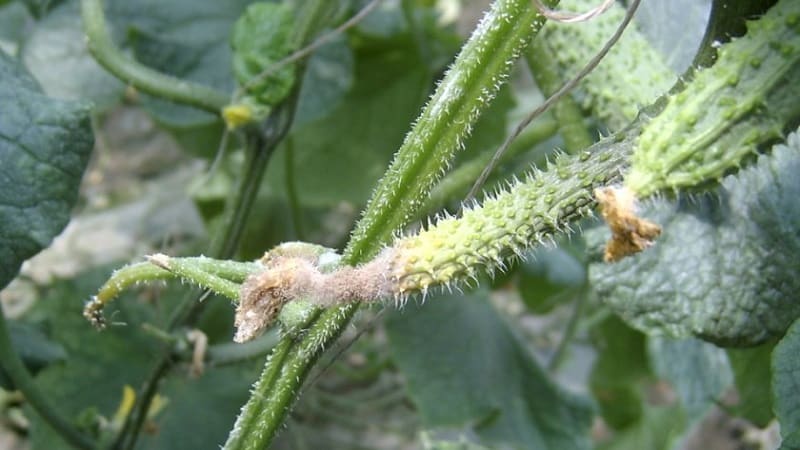
Ascochyta blight or black rot
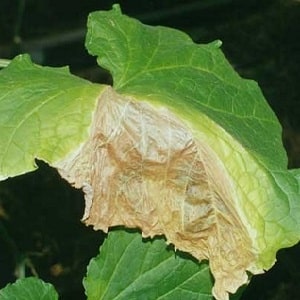 Ascochyta blight develops in the spring. Ideal conditions – high humidity and low temperatures.
Ascochyta blight develops in the spring. Ideal conditions – high humidity and low temperatures.
Black, weeping spots appear on infected plants.Over time, they begin to turn white and spread throughout the plant. The leaves take on a reddish tint. The fruits dry out and wrinkle, then begin to rot.
A mixture of chalk and copper is applied to the affected plants. in a 1:1 ratio. Additionally, they are sprayed with Bordeaux mixture or copper sulfate.
Black mold
Black mold is also called leaf blight. It usually forms in open ground.
Black or purple spots form on the ground part of the bush. Sometimes they look like cobwebs. The leaves begin to fall and the plant dies.
In the initial stages, it is realistic to deal with the problem. To do this, the affected areas are removed, and the resulting “wounds” are treated with ash.
Anthracnose
Anthracnose affects adult plants and seedlings. In the first case, the disease affects the cotyledon leaves, and in the second, the entire above-ground part of the plant.
The disease manifests itself in the form of yellow and brown round spots and pink plaque. Soon, ulcers form on the bushes, which gradually increase in size and kill the entire plant. In some cucumbers, signs of the disease appear even on the roots. In this case, the disease is determined by limp, wrinkled fruits. A photo of the disease on the leaves of affected cucumbers will help to recognize anthracnose in time.
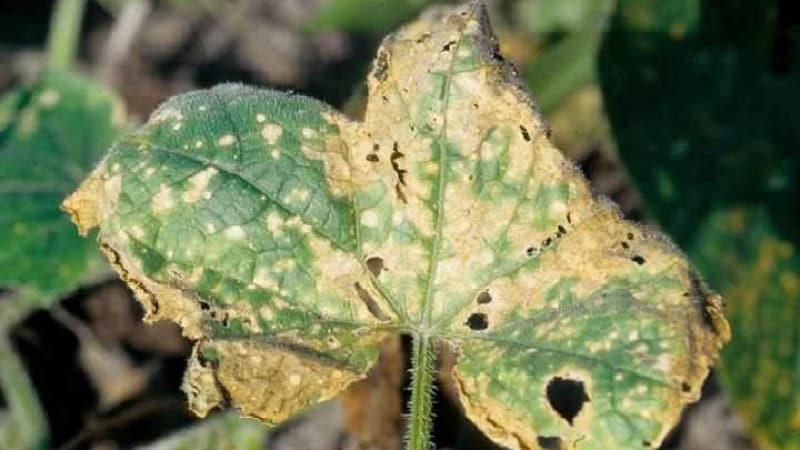
When the first signs of the disease are detected cucumbers are sprayed weekly with Bordeaux mixture or bleach solution at the rate of 35 g per 10 liters of water. Treatment is stopped 3 weeks before harvest.
Cladosporiosis, or olive spot
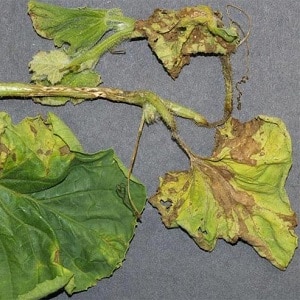 Olive spot spreads through the air during precipitation and irrigation. It appears as soft yellow-green spots on the fruits, less often on the leaves, which harden over time.
Olive spot spreads through the air during precipitation and irrigation. It appears as soft yellow-green spots on the fruits, less often on the leaves, which harden over time.
This leads to distortion and cracking of the fruit. In this case, all new ovaries fall off.
If cucumbers are already sick with cladosporiosis, then they will not be cured. Affected bushes are removed from the area and burned. Healthy plants and the soil around them are treated with Fitosporin.
Rhizoctoniosis
 Rhizoctoniosis is called black scab. More often the disease affects seedlings, but adult plants can also get sick in those parts that come into contact with the ground.
Rhizoctoniosis is called black scab. More often the disease affects seedlings, but adult plants can also get sick in those parts that come into contact with the ground.
When the disease occurs, the root collar of the cucumber becomes covered with rusty spots. Brown sores form on fruits and leaves that touch the ground. The affected parts die over time, leading to the death of the entire plant.
Affected plants are cleaned of lower leaves and fruits and sprayed with Baktofit. Plants with damaged root collars are removed.
Fusarium or verticillium
Fusarium wilt affects seedlings and adult plants. Infected cucumbers begin to lose turgor. The stems and individual vines rot first, then the entire plant. At the same time, the bushes do not change color.
Bacteria usually infect through “wounds” that form during gardening and pruning. The fungus grows quickly in conditions of high temperature and humidity.
Fusarium in the initial stages is treated with "Fitosporina". In an advanced state, the disease cannot be treated. Affected plants are removed from the beds and burned.
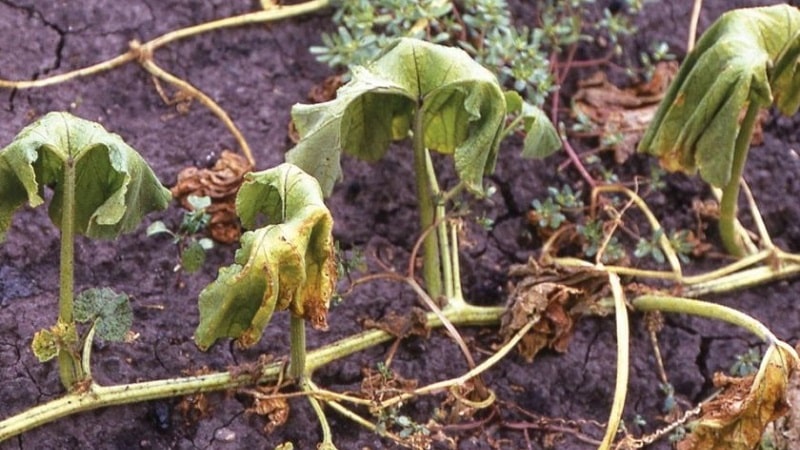
Alternaria blight
Alternaria blight on cucumber is called dry spot. Convex small dry spots indicate infection, which are formed at the bottom of the sheet. Soon the spots increase in size, merging into a whole formation. Dense dark fungal spores appear on the leaves. After some time, the affected bushes die.
When signs of disease appear, plants are sprayed copper sulfate (1 tbsp per bucket of water) or 1% Bordeaux mixture.
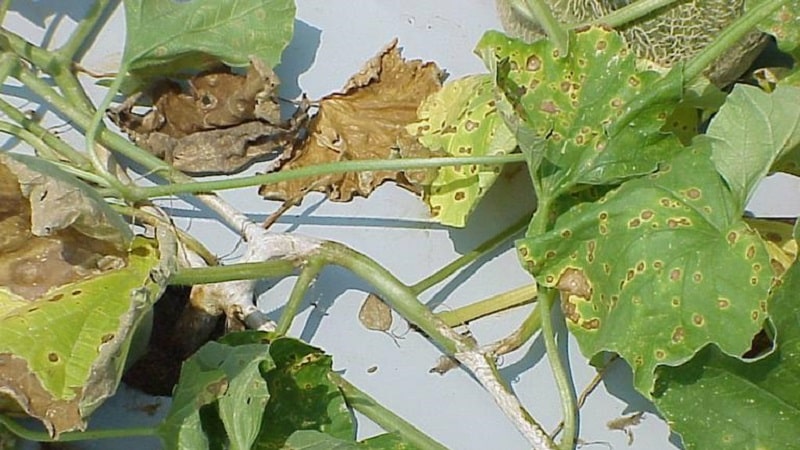
Bacterial diseases
Angular spotting, or bacteriosis, is a disease that transmitted through water, infected plants and insects. It appears in the form of angular holes and brown dry ulcers on the leaf plate.
When symptoms of illness appear cucumbers are treated with Bordeaux mixture or "Fitosporin".
Wet rot manifests itself in the form of small (1-1.5 mm in diameter) oily spots on cucumbers. The fruits are deformed and small. For prevention, Bordeaux mixture and copper-containing preparations are used.
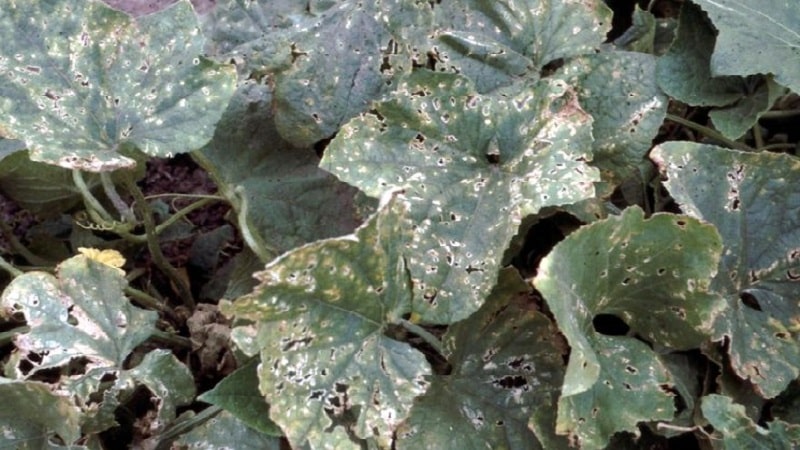
Viral diseases of cucumber
Viral plant diseases are the most dangerous. They cannot be cured, since the pathogen penetrates the cells of cucumbers and changes them. Affected plants must be removed.
There are few viral diseases of cucumber. Many modern varieties are immune to them.
Mosaics
Green mosaic – one of the most common diseases (pictured). With this disease, the greens of cucumbers become covered with light green spots and become wrinkled. Flowers stop forming, and the fruits become covered with bumps and multi-colored spots.

White mosaic is a disease in which cucumber leaves become covered star-shaped spots of white or yellow color. The fruits acquire a striped yellow-white color.
Viral necrosis of cucumber
Viral necrosis of cucumber is a disease that develops when there is a lack of nutrients in the soil. A culture with a weakened immune system becomes more susceptible to infection.
The leaf blades of affected plants acquire a yellow-violet color. Soon the ground part becomes covered with brown spots. Flowers and vines fall off, but new ones are not formed. Ultimately, the cucumber plantings die.
It is impossible to cure diseased plants. They are removed from the site and burned. Healthy plants are fed with complex fertilizers with potassium, phosphorus and manganese.
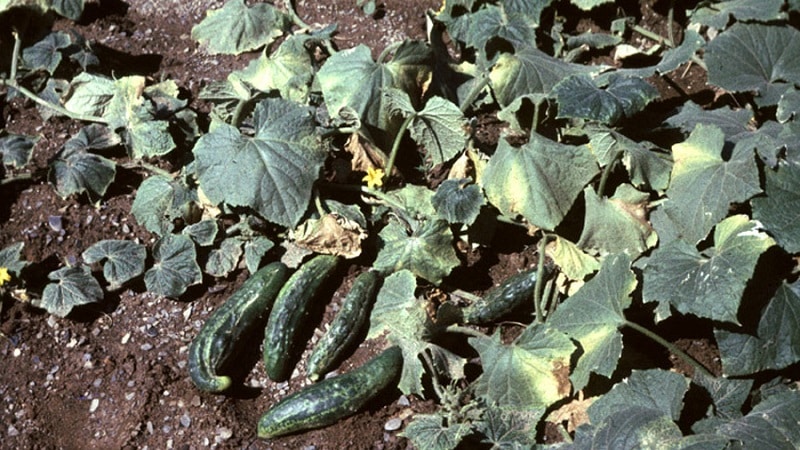
Pests of cucumbers
Pests feed on foliage and young cucumbers during fruiting. This often leads to the death of plants and damage to the crop. Insects also carry pathogens of fungal and viral infections..
Pests of cucumbers:
- Aphid. Small green insects that feed on the juice of cucumbers. To get rid of aphids, use a medicinal infusion made from garlic, onion and water (200 g of chopped vegetables per 10 liters of water) or a soap solution prepared from a bar of soap and a bucket of water.
- Spider mite. Plants become covered with cobwebs, turn yellow and dry out. To get rid of this problem, the bushes are sprayed with decoctions of bitter herbs (celandine, wormwood, yarrow, dandelion) or a soap solution.
 Root nematode (photo of affected roots on the right). It settles in the roots of plants, slowing down their growth and reducing the quality of the fruit. The fight against this pest is ineffective. The contaminated soil is treated with boiling water.
Root nematode (photo of affected roots on the right). It settles in the roots of plants, slowing down their growth and reducing the quality of the fruit. The fight against this pest is ineffective. The contaminated soil is treated with boiling water.- Medvedka. Eats plant roots. The only method of prevention is to remove its larvae while digging up the site.
- Slugs. They eat cucumber leaves. They are collected by hand. Another option is to scatter granules of the drug “Groza” between the rows.
- Sprout fly. The fly and its larvae feed on the greens and fruits of the plant.To get rid of pests, the bushes are treated with Funanon or Kemifos.
- Cucumber bug. Lives on the underside of leaves and sucks juice from them. They fight it with the help of chemicals “Barrier”, “Kemifos” and “Funanon”.
- Cucumber mosquito. It lays larvae in the soil that gnaw holes in the roots of plants. As a preventive measure, the soil is doused with boiling water and all plant remains are removed.
- Wireworm. The larva of the nutcracker beetle attacks the roots of plants. If the insect has already settled in the beds, then it is impossible to get rid of it. As a preventative measure, reduce the acidity of the soil by sprinkling it with dry lime or ash.
- Ants. They gnaw the leaves and fruits of cucumbers. To get rid of pests, anthills are doused with boiling water. The soil in the beds is sprinkled with ash.
- Greenhouse whitefly. A small white insect that resembles an aphid. Destroys plants. They fight it with the help of chemicals “Bud” or “Iskra”.
- Thrips. The underside of the leaves is covered with small transparent and black insects that suck the juice from the plants. To get rid of the pest, the crop is sprayed with a decoction of bitter herbs or onion infusion - 100 g per 10 liters of water. Chemical agents “Fury”, “Aktara” or “Calypso” are used.
Features of pests and diseases in the greenhouse and in the open ground
Contrary to the opinion of some gardeners, in a greenhouse, diseases strike as often as in open ground. Moreover, infections spread faster indoors. This is facilitated not only by reduced air exchange, but also by condensation in the building.
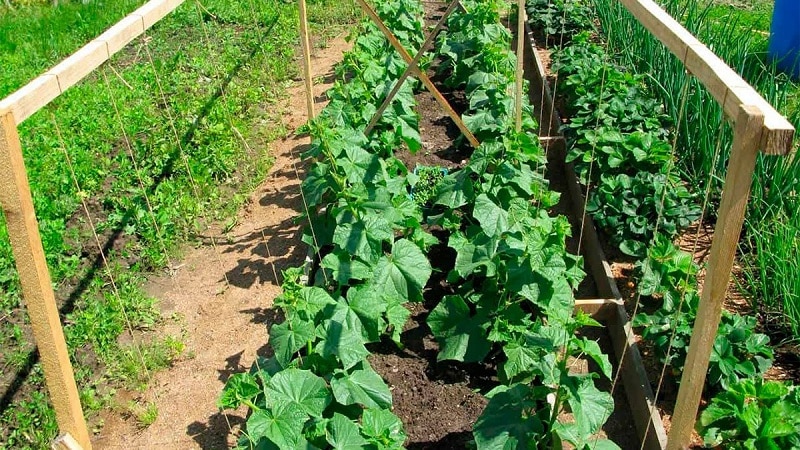
In open ground, disease development is facilitated by temperature changes.To reduce the likelihood of infection, the beds are covered with film during cold weather.
It is easier to protect plantings from insects in a greenhouse than in open ground. To do this, it is enough to put mosquito nets on the windows.
Note! Most diseases affect plants in May, August and September, when constant cold snaps are possible.
Prevention measures against diseases and pests
Preventing cucumber diseases is easier than treating them. To To prevent plant infection, it is important to follow the basic rules:
- Maintaining crop rotation. Cucumbers are not planted in beds where melons have been grown in the past two years or where disease outbreaks have been observed.
- Removal of plant residues. It is important to clear the beds of weeds.
- Disinfection. Disinfecting solutions are used to treat soil, seedling containers, greenhouse walls, seeds and garden tools.
- Compliance with watering rules. To do this, use settled water at room temperature. The soil should not be too wet or dry. The soil is moistened when the sun is inactive.
- Ensuring normal air exchange. To do this, the beds are loosened after each watering and precipitation. The greenery at the bottom of the bush is removed.
- Compliance with the rules of stepsoning. Plants are planted early in the morning or in the evening in dry weather. On the day of planting, the beds are not watered.
- Feeding. At least two mineral fertilizers are applied per season. These should include phosphorus, potassium and urea.
- Preventive treatments. Plants are sprayed with antifungal agents or serum diluted 1:10 with water after heavy rains and cold weather.
- Using drainage when growing seedlings. Containers must have holes.
- Mulching and hilling.This will protect the roots from negative environmental factors and contribute to the development of a powerful root system.
Conclusion
Diseases of cucumbers are the main obstacle to obtaining a rich harvest. Mistakes by the site owner and unfavorable weather conditions can contribute to their occurrence.
Fighting plant diseases is much more difficult than taking preventive measures. Therefore, the main thing for a beginning gardener is to strictly follow the rules of planting and caring for cucumbers.